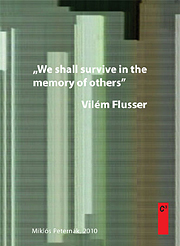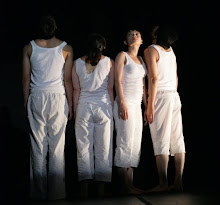If the computer understands nature it will understand it only in a way understandable to other computers. Computers may someday become so sophisticated as to understand us, too, but they will only be able to communicate this understanding to other computers.
This is a review of 'Rheo' a media performance by Ryoichi Kurokawa on three vertically hung HD projections with 5.1 sound around 9pm on June 29th 2010, at the Haus der Kulturen der Welt, Berlin. Since all of his images are copyright, I have not posted any here, please go to his site to get a good notion of what I am discussing below.
What I saw:
The last 15 minutes or so, to be honest, but I think I got a good sense of what was at stake.
The image quality is pristine, exquisite digital photography of natural phenomena, waves, stony crags, etc go through a computer process which eventually disintegrates them into clouds of swirling vectors. In HD every one of these vectors retains its sharpness, yet the sheer numbers of them and their erratic motion produce a noise-like blur. In all, the HD resolution is very well exploited. The visuals have a certain rhythmicity, and this is reinforced, or propagated by the soundtrack. The full range of the audible spectrum is mined with precision for strong sensory effects. There is a lot of high frequency noise and sine waves, loud bursts of noise crackling the speakers like fireworks, always in synchrony with a corresponding burst of activity or abrupt cut on the screen. Other sections are more pastoral, exquisite computer simulations of waterfalls (created of the same incredible sharp and fine vectors), accompanied by field recordings of birds and, well, fields, drawn out with Japanese Sho contributing a noble art pedigree to the event. Sometimes the photography would be used in rapid successions, flipping through a database labeled "Nature" at the speed of heat.
What I thought.
For all it's mastery, the result was flat. Sonically, graphically, however, there was nothing to reproach, the timing of the ebbs and flows the darks to lights and louds to softs was impeccable, the sounds chosen to synchronize with visual events were all finely sculpted. Yet, the work showed me something I wrote about 2 years ago is still the case. It is difficult for artists who work only with digital media to transcend the flattening that makes digital media so marvelously malleable and transmutable. I have noticed this particularly among the digital artist of Japan and Korea. Ryoji Ikeda is another good example where there is an attempt to warm up the screen by submitting it to a barrage of content, reams of image information are reflected at the viewer at ecstatic rates, the fineness of the detail allows up almost to be able to see the detailing of time itself. This is art of the nerves, it is a flat art of electronic impulses of stimuli without (need of) emotional response.
What I think I saw was the computer struggling to encapsulate the complexity of the Nature in a photograph of Nature, extracting hypothetical surfaces from something that has already once been flattened. (Nature is flattened by digital photography into an array of data, the image we see on the screen apears much more coherent that the streams of homogenous bits the computer is attempting to understand). The computer's calculator flutters over the image attempting to distinguish light masses from dark, contingent forms. The algorithms of its automated interpretation is designed in this case to be purposefully over-cautious and inefficient but it works at near light speed. These inefficient algorithms are principle artistic elements of the work, slowing down and exaggerating the computer's interpretation of the image so that we may experience it aesthetically. In this approximate understanding of the image, the computer creates medial images where the areas of more certainly begin to blur and merge.
At this juncture where the original image is imperceptible behind clouds of approximating vectors, Kurokawa will usually reverse the process. This indistinct, overanalysed nether image is morphed to an advanced vectorization of another image, and from here, the ecstatic approximations work now (imperceptibly) in reverse until a new photographic Nature-vignette inexorably comes into startling clarity and detail.
This is truly art of the state-of-the-art. As the computer struggles to make sense of the empirical data, Kurokawa struggles to make sense of the computer. The conclusion of the performance is, unfortunately, a cop out. Kurokawa attempts to understand the computer by setting before its calculating sensorium the figure of Nature. At the end of the show, the medial 'nether' image, instead of coalescing into a photograph of Nature, coalesces into one of a city. A city neither ominous nor luminous, a city pictured in the same exquisite HD sharpness as had been Nature. City as a natural encrustation produced by Homo Faber, itself a natural phenomena.
Nature is calculated into the form of the city, but is the city the end of calculation? The city is the site where calculations converge exponentially. The expectation is, following Moore's Law, that quantum computing is imminent, a form of simultaneous automated calculation capable of the complexity of human mental process, and beyond. The city will be calculated into the excity where matter is constantly reorganized on the atomic level in realtime, and human beings will be transfused with automated processes on the atomic level (atomatons?). The promise is that all disease will be curable, even death. All that matters is to keep the computers going.
The possibility that somehow an 'energy crisis' may cause the current feeding these automated processes to be interrupted, makes this a race against time with the computers indefatigably calculating the solution. Part of the solution is, of course, the improvement of computers which will be used to calculate the solution. Eventually the computers will know some solutions, and they may even know that they know some solutions and even know that they should communicate such results to us. It is likely that their solutions will only be able to be carried out by computer-designed automated processes. The only solution will be to trust the computers.
The drama of the computer attempting to preserve our species is an indifferent one.
This was made immediately palpable as I left the auditorium into a wonderful and unfamiliar sound. The public areas of Haus der Kulturen der Welt are contiguous, from the doors at the ticket booths through the immense foyer up to the auditorium, along the mezzanine, down along the cavernous coat check area all the way back to the cafe and the office areas, it is one uninterrupted space. For the Rencontres Internationales digital arts festival at which Ryoichi Kurokawa performed for the opening, the organizers were prescient enough to install a massive screen in the foyer for those who wanted to take a break from the high culture to catch some of the World Cup. What I had heard on exiting the auditorium was the sound of about a hundred football watchers reacting to a near miss in the game between Spain and Portugal. The sound had traveled around 50 meters bouncing across all manner of surfaces to reach me, in the process it had become a brief passing cloud of excited human voice.
(thank you to SA for the quick read-over and suggestions)












